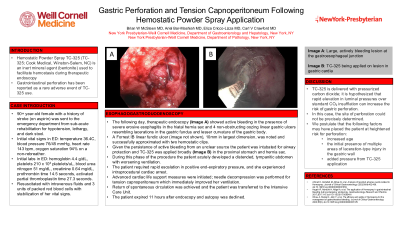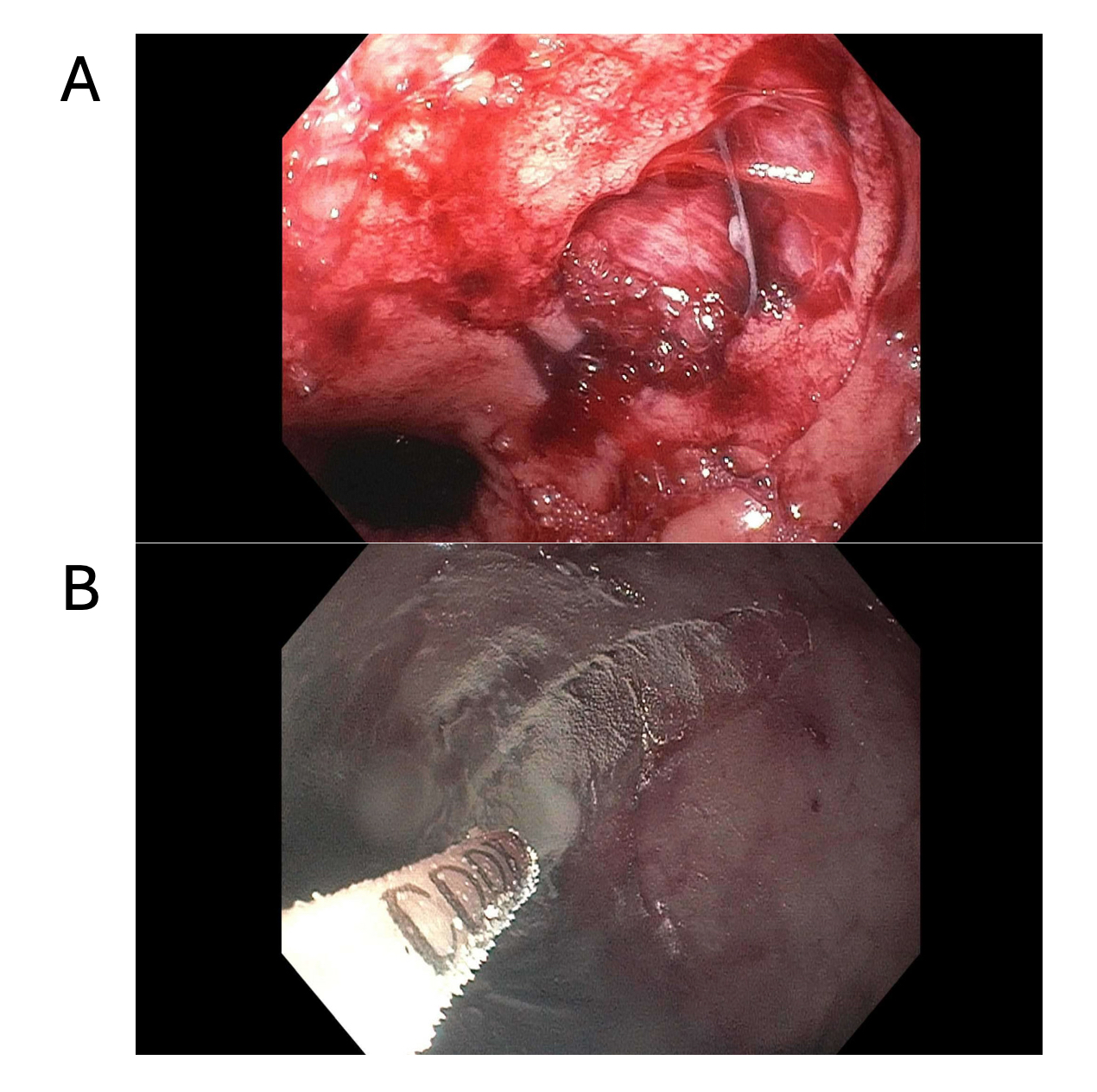Tuesday Poster Session
Category: General Endoscopy
P4138 - Gastric Perforation and Tension Capnoperitoneum Following Hemostatic Powder Spray Application
Tuesday, October 29, 2024
10:30 AM - 4:00 PM ET
Location: Exhibit Hall E

Has Audio
.jpg)
Brian W. McSteen, MD
New York-Presbyterian / Weill Cornell Medical Center
New York, NY
Presenting Author(s)
Brian W. McSteen, MD1, Ariel Bar-Mashiah, MD2, Eliza Cricco-Lizza, MD1, Carl V. Crawford, MD1
1New York-Presbyterian / Weill Cornell Medical Center, New York, NY; 2New York-Presbyterian Hospital/Weill Cornell Medical Center, New York, NY
Introduction: Hemostatic Powder Spray TC-325 (TC-325; Cook Medical, Winston-Salem, NC) is an inert mineral agent (bentonite) used to facilitate hemostasis during endoscopic evaluation. Gastrointestinal perforation has been reported as a rare adverse event of TC-325 use.
Case Description/Methods: A 90+ year-old female with a history of stroke (on aspirin) was sent to the emergency department from sub-acute rehabilitation for hypotension, lethargy, and dark stool. Upon arrival, her vital signs were temperature 36.4C, blood pressure 76/45 mmHg, heart rate 143 bpm, oxygen saturation 94% on a non-rebreather. Her labs showed: hemoglobin 4.4 g/dL, platelets 210 x 103 platelets/uL, blood urea nitrogen 51 mg/dL, creatinine 0.64 mg/dL, prothrombin time 14.5 seconds, activated partial thromboplastin time 27.3 seconds. She received intravenous fluid resuscitation and 3 units of packed red blood cells with stabilization of her vital signs. The following day, esophagogastroduodenoscopy showed active bleeding in the presence of severe erosive esophagitis in the hiatal hernia sac and 4 non-obstructing oozing linear gastric ulcers in the gastric fundus and lesser curvature of the gastric body. A Forrest IB linear fundic ulcer, 10mm in largest dimension, was noted and successfully approximated with two hemostatic clips. Given the persistence of active bleeding from an unclear source the patient was intubated for airway protection and TC-325 was applied broadly in the proximal stomach and hernia sac.
During this phase of the procedure the patient acutely developed a distended, tympanitic abdomen. Her ventilation worsened requiring higher positive end-expiratory pressure, and she experienced intraprocedural cardiac arrest. Advanced cardiac life support measures were initiated; needle decompression was performed for tension capnoperitoneum which immediately improved her ventilation. Return of spontaneous circulation was achieved and the patient was transferred to the Intensive Care Unit. The patient later expired and autopsy was declined.
Discussion: As TC-325 is delivered with pressurized carbon dioxide, it is hypothesized that rapid elevation in luminal pressures over standard CO2 insufflation increased the perforation risk. The site of perforation could not be determined in this case. We postulate that increased age, the initial presence of multiple areas of laceration-type injury in the gastric wall, and added pressure from TC-325 application may have placed the patient at heightened risk for this complication.

Disclosures:
Brian W. McSteen, MD1, Ariel Bar-Mashiah, MD2, Eliza Cricco-Lizza, MD1, Carl V. Crawford, MD1. P4138 - Gastric Perforation and Tension Capnoperitoneum Following Hemostatic Powder Spray Application, ACG 2024 Annual Scientific Meeting Abstracts. Philadelphia, PA: American College of Gastroenterology.
1New York-Presbyterian / Weill Cornell Medical Center, New York, NY; 2New York-Presbyterian Hospital/Weill Cornell Medical Center, New York, NY
Introduction: Hemostatic Powder Spray TC-325 (TC-325; Cook Medical, Winston-Salem, NC) is an inert mineral agent (bentonite) used to facilitate hemostasis during endoscopic evaluation. Gastrointestinal perforation has been reported as a rare adverse event of TC-325 use.
Case Description/Methods: A 90+ year-old female with a history of stroke (on aspirin) was sent to the emergency department from sub-acute rehabilitation for hypotension, lethargy, and dark stool. Upon arrival, her vital signs were temperature 36.4C, blood pressure 76/45 mmHg, heart rate 143 bpm, oxygen saturation 94% on a non-rebreather. Her labs showed: hemoglobin 4.4 g/dL, platelets 210 x 103 platelets/uL, blood urea nitrogen 51 mg/dL, creatinine 0.64 mg/dL, prothrombin time 14.5 seconds, activated partial thromboplastin time 27.3 seconds. She received intravenous fluid resuscitation and 3 units of packed red blood cells with stabilization of her vital signs. The following day, esophagogastroduodenoscopy showed active bleeding in the presence of severe erosive esophagitis in the hiatal hernia sac and 4 non-obstructing oozing linear gastric ulcers in the gastric fundus and lesser curvature of the gastric body. A Forrest IB linear fundic ulcer, 10mm in largest dimension, was noted and successfully approximated with two hemostatic clips. Given the persistence of active bleeding from an unclear source the patient was intubated for airway protection and TC-325 was applied broadly in the proximal stomach and hernia sac.
During this phase of the procedure the patient acutely developed a distended, tympanitic abdomen. Her ventilation worsened requiring higher positive end-expiratory pressure, and she experienced intraprocedural cardiac arrest. Advanced cardiac life support measures were initiated; needle decompression was performed for tension capnoperitoneum which immediately improved her ventilation. Return of spontaneous circulation was achieved and the patient was transferred to the Intensive Care Unit. The patient later expired and autopsy was declined.
Discussion: As TC-325 is delivered with pressurized carbon dioxide, it is hypothesized that rapid elevation in luminal pressures over standard CO2 insufflation increased the perforation risk. The site of perforation could not be determined in this case. We postulate that increased age, the initial presence of multiple areas of laceration-type injury in the gastric wall, and added pressure from TC-325 application may have placed the patient at heightened risk for this complication.

Figure: Image A: Large, actively bleeding lesion at the gastroesophageal junction
Image B: TC-325 being applied on lesion in gastric cardia
Image B: TC-325 being applied on lesion in gastric cardia
Disclosures:
Brian McSteen indicated no relevant financial relationships.
Ariel Bar-Mashiah indicated no relevant financial relationships.
Eliza Cricco-Lizza indicated no relevant financial relationships.
Carl Crawford: Ferring – Grant/Research Support. Nestle – Speakers Bureau. Phathom – Speakers Bureau. Seres – Speakers Bureau. Vedanta – Grant/Research Support.
Brian W. McSteen, MD1, Ariel Bar-Mashiah, MD2, Eliza Cricco-Lizza, MD1, Carl V. Crawford, MD1. P4138 - Gastric Perforation and Tension Capnoperitoneum Following Hemostatic Powder Spray Application, ACG 2024 Annual Scientific Meeting Abstracts. Philadelphia, PA: American College of Gastroenterology.

